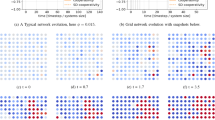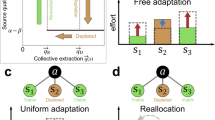Abstract
Sustainable use of common-pool resources is a major environmental governance challenge because of possible overexploitation. Communities devise self-governing institutions that avoid overuse and attain long-term benefits of cooperation. It is still unclear, however, what conditions allow cooperation to emerge, leading to greater long-term benefits. Until recently, studies of the sustainable governance of common-pool resources have overlooked feedback between user decisions and resource dynamics and failed to test the ability of shared goals to actually induce cooperation. Here we develop an online game to perform a set of experiments in which users of the same common-pool resource decide on their individual harvesting rates, which in turn are influenced by the resource dynamics. We show that if users share common goals, a high level of self-organized cooperation emerges, leading to long-term resource sustainability. Otherwise, selfish/individualistic behaviours lead to resource depletion. To explain these results, we develop a model of resource-decision dynamics based on optimal control theory and show how it is able to reproduce empirical results. We find that players self-organize and engage in collective action conducive to sustainable governance of common-pool resources by trade-off strategies that balance individual and collective payoff as well as short-term and long-term rewards.
This is a preview of subscription content, access via your institution
Access options
Access Nature and 54 other Nature Portfolio journals
Get Nature+, our best-value online-access subscription
$29.99 / 30 days
cancel any time
Subscribe to this journal
Receive 12 digital issues and online access to articles
$119.00 per year
only $9.92 per issue
Buy this article
- Purchase on Springer Link
- Instant access to full article PDF
Prices may be subject to local taxes which are calculated during checkout





Similar content being viewed by others
Data availability
Data for all analyses are available at OSF (https://osf.io/txus6/).
Code availability
Code for all analyses is available at OSF (https://osf.io/txus6/).
References
Davis, K. F., D’Odorico, P. & Rulli, M. C. Moderating diets to feed the future. Earths Future 2, 559–565 (2014).
Suweis, S., Carr, J. A., Maritan, A., Rinaldo, A. & D'Odorico, P. Resilience and reactivity of global food security. Proc. Natl Acad. Sci. USA 112, 6902–6907 (2015).
Dietz, T., Ostrom, E. & Stern, P. C. The struggle to govern the commons. Science 302, 1907–1912 (2003).
Ostrom, E. The challenge of common-pool resources. Environ. Sci. Policy Sustain. Dev. 50, 8–21 (2008).
Ostrom, E. A general framework for analyzing sustainability of social-ecological systems. Science 325, 419–422 (2009).
Ostrom, E. Governing the Commons: The Evolution of Institutions for Collective Action (Cambridge Univ. Press, 1990).
Van Laerhoven, F. & Ostrom, E. Traditions and trends in the study of the commons. Int. J. Commons 1, 3–28 (2007).
Rocha, J. C., Schill, C., Saavedra-Díaz, L. M., Moreno, R. D. P. & Maldonado, J. H. Cooperation in the face of thresholds, risk, and uncertainty: experimental evidence in fisher communities from Colombia. PLoS ONE 15, e0242363 (2020).
Maldonado, J. H. & Moreno-Sanchez, Rd. P. Exacerbating the tragedy of the commons: private inefficient outcomes and peer effect in experimental games with fishing communities. PLoS ONE 11, e0148403 (2016).
Baragwanath, K. & Bayi, E. Collective property rights reduce deforestation in the Brazilian Amazon. Proc. Natl Acad. Sci. USA 117, 20495–20502 (2020).
Romulo, C. L., Kennedy, C. J., Gilmore, M. P. & Endress, B. A. Sustainable harvest training in a common pool resource setting in the Peruvian Amazon: limitations and opportunities. Trees For. People 7, 100185 (2022).
Hardin, G. The tragedy of the commons. Science 162, 1243–1248 (1968).
Tavoni, A., Schlüter, M. & Levin, S. The survival of the conformist: social pressure and renewable resource management. J. Theor. Biol. 299, 152–161 (2012).
Hauser, O. P., Rand, D. G., Peysakhovich, A. & Nowak, M. A. Cooperating with the future. Nature 511, 220–223 (2014).
Hilbe, C., Šimsa, Š., Chatterjee, K. & Nowak, M. A. Evolution of cooperation in stochastic games. Nature 559, 246–249 (2018).
Sethi, R. & Somanathan, E. The evolution of social norms in common property resource use. Am. Econ. Rev. 86, 766–788 (1996).
Runyan, C. W., D’Odorico, P. & Shobe, W. The economic impacts of positive feedbacks resulting from deforestation. Ecol. Econ. 120, 93–99 (2015).
Tilman, A. R., Plotkin, J. B. & Akçay, E. Evolutionary games with environmental feedbacks. Nat. Commun. 11, 915 (2020).
Janssen, M. A. Introducing ecological dynamics into common-pool resource experiments. Ecol. Soc. http://www.jstor.org/stable/26268126 (2010).
Casari, M. & Plott, C. R. Decentralized management of common property resources: experiments with a centuries-old institution. J. Econ. Behav. Organ. 51, 217–247 (2003).
Crépin, A.-S. & Lindahl, T. Grazing games: sharing common property resources with complex dynamics. Environ. Resour. Econ. 44, 29–46 (2009).
Clark, C. W. in Mathematical Problems in Biology (ed. van den Driessche, P.) 29–45 (Springer, 1974).
Anderies, J. M. et al. The challenge of understanding decisions in experimental studies of common pool resource governance. Ecol. Econ. 70, 1571–1579 (2011).
Ostrom, E. The value-added of laboratory experiments for the study of institutions and common-pool resources. J. Econ. Behav. Organ. 61, 149–163 (2006).
Schlüter, M. & Pahl-Wostl, C. Mechanisms of resilience in common-pool resource management systems: an agent-based model of water use in a river basin. Ecol. Soc. 12, 2 (2007).
Cardenas, J.-C., Janssen, M. & Bousquet, F. in Handbook on Experimental Economics and the Environment (Edward Elgar Publishing, 2013).
Turner, B. L. et al. Illustrating the coupled human–environment system for vulnerability analysis: three case studies. Proc. Natl Acad. Sci. USA 100, 8080–8085 (2003).
Liu, J. et al. Systems integration for global sustainability. Science 347, 1258832 (2015).
Ostrom, E., Gardner, R., Walker, J., Walker, J. M. & Walker, J. Rules, Games, and Common-Pool Resources (Univ. of Michigan Press, 1994).
Ostrom, E. Understanding Institutional Diversity (Princeton Univ. Press, 2009).
Nelder, J. A. The fitting of a generalization of the logistic curve. Biometrics 17, 89–110 (1961).
Verhulst, P.-F. Notice sur la loi que la population suit dans son accroissement. Corresp. Math. Phys. 10, 113–126 (1838).
Tsoularis, A. & Wallace, J. Analysis of logistic growth models. Math. Biosci. 179, 21–55 (2002).
Barabasi, A.-L. & Albert, R. Emergence of scaling in random networks. Science 286, 509–512 (1999).
Watts, D. J. & Strogatz, S. H. Collective dynamics of ‘small-world’ networks. Nature 393, 440–442 (1998).
Traulsen, A., Claussen, J. C. & Hauert, C. Coevolutionary dynamics: from finite to infinite populations. Phys. Rev. Lett. 95, 238701 (2005).
Kreyszig, E. Introductory Functional Analysis With Applications 1 (John Wiley & Sons, 1978).
Lenhart, S. & Workman, J. T. Optimal Control Applied To Biological Models (Chapman and Hall/CRC, 2007).
Lewis, F. L., Vrabie, D. & Syrmos, V. L. Optimal Control (John Wiley & Sons, 2012).
Conway, J. B. A Course in Functional Analysis Vol. 96 (Springer, 2019).
Koenemann, J., Licitra, G., Alp, M. & Diehl, M. OpenOCL–Open Optimal Control Library (2017).
Göllner, L. M., Ballhausen, N., Kliegel, M. & Forstmeier, S. Delay of gratification, delay discounting and their associations with age, episodic future thinking, and future time perspective. Front. Psychol. 8, 2304 (2017).
Wilson, D. S. & Sober, E. Reintroducing group selection to the human behavioral sciences. Behav. Brain Sci. 17, 585–608 (1994).
Wilson, D. S. & Wilson, E. O. Rethinking the theoretical foundation of sociobiology. Q. Rev. Biol. 82, 327–348 (2007).
Traulsen, A. & Nowak Martin, A. Evolution of cooperation by multilevel selection. Proc. Natl Acad. Sci. USA 103, 10952–10955 (2006).
Eckel, C. C., Fatas, E., Godoy, S. & Wilson, R. K. Group-level selection increases cooperation in the public goods game. PLoS ONE 11, e0157840 (2016).
Tu, C., D’Odorico, P., Li, Z. & Suweis, S. Systemic Sustainability Game https://systemic-sustainability.com (2022).
Acknowledgements
This work was supported by Microsoft AI for Earth (C.T.); Experimental Social Science Laboratory at University of California Berkeley (C.T. and P.D.); Natural Science Fund of Zhejiang Province under Grant No. LZ18G010001, LZ22G010001; Science Foundation of Zhejiang Sci-Tech University under Grant No. 18092125-Y, 22092034-Y (C.T.); LINCON INFN grant (S.S.) and BIRD_UNIPD grant (S.S.).
Author information
Authors and Affiliations
Contributions
C.T. and S.S. conceptualized the project. C.T., Z.L. and S.S. developed the methodology. C.T., P.D. and S.S. conducted the investigations. C.T. and S.S. performed visualization. C.T., P.D. and S.S. acquired funding. P.D. and S.S. administered the project. S.S. supervised the project and wrote the original draft. C.T., P.D. and S.S. wrote, reviewed and edited the manuscript.
Corresponding authors
Ethics declarations
Competing interests
The authors declare no competing interests.
Peer review
Peer review information
Nature Sustainability thanks Christiane Runyan and the other, anonymous, reviewer(s) for their contribution to the peer review of this work.
Additional information
Publisher’s note Springer Nature remains neutral with regard to jurisdictional claims in published maps and institutional affiliations.
Supplementary information
Supplementary Information
Supplementary Notes, Figs. 1–28 and References.
Supplementary Table 1
All the details of the box-and-whisker charts shown in Fig. 2 and Supplementary Figs. 9–12, including mean, standard deviation, median, minimum, maximum, first quartile and third quartile.
Supplementary Table 2
Detailed description of the statistical tests for Fig. 2.
Supplementary Table 3
Detailed description of the statistical tests for Supplementary Figs. 9–12 by ANOVA.
Supplementary Table 4
Detailed description of the statistical tests for Supplementary Figs. 9–12 by Mann-Whitney test with Bonferroni correction.
Rights and permissions
Springer Nature or its licensor (e.g. a society or other partner) holds exclusive rights to this article under a publishing agreement with the author(s) or other rightsholder(s); author self-archiving of the accepted manuscript version of this article is solely governed by the terms of such publishing agreement and applicable law.
About this article
Cite this article
Tu, C., D’Odorico, P., Li, Z. et al. The emergence of cooperation from shared goals in the governance of common-pool resources. Nat Sustain 6, 139–147 (2023). https://doi.org/10.1038/s41893-022-01008-1
Received:
Accepted:
Published:
Issue Date:
DOI: https://doi.org/10.1038/s41893-022-01008-1
This article is cited by
-
Cooperate to save a changing planet
Nature Sustainability (2022)



